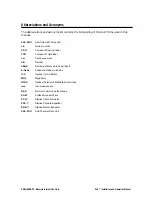
Bench
Testing
4-3
PRELIMINARY - Motorola Internal Use Only
SLE*-* Installation and Operation Manual
5
Measure the gain at mixed forward frequency using the procedure outlined in the operator
manual provided with the test equipment in use.
To correct this number, add the insertion loss of the SSP-PIN power combiner (0.5 dB at
550 MHz, 0.6 dB at 750 MHz, or 0.7 dB at 870 MHz), the loss of the cable simulator at
mixed forward frequency, and the loss of the cable equalizer (1.0 dB), if it is installed.
Example:
The test equipment indicates a measured gain of 14.5 dB with an SLE87S/* and the cable
simulator is set to 20 dB.
+0.7 dB (power combiner)
+1.0 dB (cable equalizer)
+20.0 dB (cable simulator)
+14.5 dB (measured gain)
+36.2 dB (unit gain)
The result must meet advertised specifications for the unit.
The operational gain of the SLE*-* provides reduced gain capability. This enables the unit to
operate in the proper region of the SLE-Bode board when it is controlled by the SLE-ADU or
SLE-TDU.
To measure the operational gain and flatness of the amplifier:
1
Perform steps 1 through 6 in Measuring Forward Gain above.
2
Estimate the ambient temperature and find the required gain reserve by referring to
Table 3-3. Reduce the gain at the highest frequency by the amount given in the table.
Example:
The ambient temperature is 70
°
F. The table indicates that the required gain reserve is 4 dB.
Reduce the gain by 4 dB.
The operational gain is the sum of the measured gain after performing Step 2, plus all
losses, such as power combiner, cable loss, equalizer, and cable simulator.
The sweep response is essentially flat at this point. If the response exhibits tilt, the cable
equalizer must be changed. Install a higher equalizer value if the gain is greater at the low
frequencies; install the next lower equalizer value if the gain is less at the low-end
frequencies.
3
Measure the gain excursions from an average value within the bandpass.
The result is the peak-to-valley (P-V) flatness. Some improvement is possible by adjusting
the flatness controls on the LDR/*/III board as described in Section 3, “Amplifier Setup,”
Flatness Control. Figure 3-3 illustrates the location of these controls on the LDR/*/III board.










































